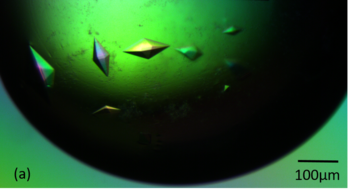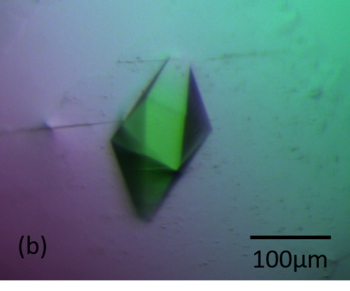Journal:IUCrJ:S2052252521005340
From Proteopedia
(Difference between revisions)

| Line 9: | Line 9: | ||
After a long search for co-crystallisation conditions involving both the whole N-terminal region of CCR5 and the minimally required binding region to its antibody (the ‘core peptide’), and the analysis and comparison of X-ray crystallographic electron density maps obtained from several crystals, we have finally located the core peptide of the CCR5 receptor bound to RoAb13. It binds at the hypervariable region ‘CDR3’ of the antibody’s light chain, an expected antigen-binding site. In spite of the fact that the best attainable resolution is not particularly high at 3 Å, we have been able to identify the interacting residues between antibody and peptide: | After a long search for co-crystallisation conditions involving both the whole N-terminal region of CCR5 and the minimally required binding region to its antibody (the ‘core peptide’), and the analysis and comparison of X-ray crystallographic electron density maps obtained from several crystals, we have finally located the core peptide of the CCR5 receptor bound to RoAb13. It binds at the hypervariable region ‘CDR3’ of the antibody’s light chain, an expected antigen-binding site. In spite of the fact that the best attainable resolution is not particularly high at 3 Å, we have been able to identify the interacting residues between antibody and peptide: | ||
| - | *<scene name='88/884898/Cv/23'>PIYDIN of the 31 peptide study</scene>. | + | *<scene name='88/884898/Cv/23'>PIYDIN of the 31 peptide study</scene>. PIYDIN is colored in orange, antibody RoAb13 in cyan/green. |
| - | *<scene name='88/884898/Cv/21'>PIYDIN only study</scene>. | + | *<scene name='88/884898/Cv/21'>PIYDIN only study</scene>. PIYDIN is colored in magenta. |
*<scene name='88/884898/Cv/22'>Interacting residues between antibody and peptide PIYDIN. Both cases</scene>. | *<scene name='88/884898/Cv/22'>Interacting residues between antibody and peptide PIYDIN. Both cases</scene>. | ||
Furthermore, the core peptide was found to bind in a way that can accommodate the full length of the CCR5 N-terminus. | Furthermore, the core peptide was found to bind in a way that can accommodate the full length of the CCR5 N-terminus. | ||
Revision as of 10:33, 14 June 2021
| |||||||||||
This page complements a publication in scientific journals and is one of the Proteopedia's Interactive 3D Complement pages. For aditional details please see I3DC.


